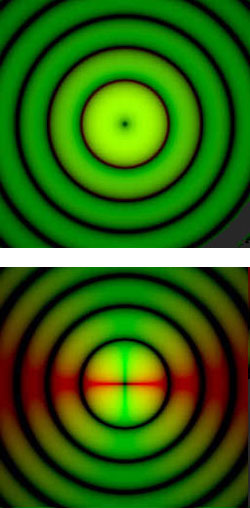The Sharpest Focus
A new technique allows light to be focused to a smaller spot than ever before, a team reports in an upcoming issue of PRL. They focused laser light with an unusual polarization down to a spot about 0.06 square micrometers in area, almost half again as small as the previous record. The tightly focused light produces an intense electromagnetic field that could be used as a probe or to manipulate atoms or other tiny objects. Researchers might also use the technique in any device that requires highly focused light, such as in microscopes or machines that etch microscale devices.
Normally a light beam will focus to a point no smaller than about the size of the light’s wavelength. Light rays from different parts of the beam cancel and reinforce one another in ways that tend to fuzz out the spot if you try to focus it too tightly. The most tightly focused spots have used so-called linearly polarized light, in which the electric field everywhere in the beam oscillates up and down, for example, and never points to the right or left. But even such pure laser light has a problem: when the beam hits a focusing lens, most of the light rays within it change direction and head toward the focus, instead of remaining parallel. In the process, the vertical electric fields at the top and bottom edges get tilted, whereas those at the left and right sides remain perfectly vertical. This asymmetry leads to some extra blurring.
Gerd Leuchs, of Erlangen-Nürnberg University in Germany, and his colleagues, predicted that radial polarization could lead to a tighter focus than the standard linear polarization. Radially polarized light has its electric field vectors arranged like spokes of a wheel pointing out from the center of the beam. As the field oscillates, it points in, out, in, out. The beam has a donut-shaped intensity pattern, with the most intense light occurring at some distance from the center and a “hole” in the middle of the beam where the intensity is zero. When radially polarized light crosses a lens, the electric field from each part of the beam is tilted symmetrically around the light beam’s path.
Leuchs and his colleagues radially polarized light from a helium-neon laser and focused it down to a point just 0.4 wavelengths across, compared with the theoretical limit of about 0.5 for linear polarization. That translates to an area around 40% smaller. As they expected, the “donut hole” shrunk down to nothing, and most of the electric field cancelled, leaving just an intense spot with the electric field pointing along the direction of the light beam.
Peter Knight, of the Imperial College in London, says the work is a “major development.” According to Emil Wolf, of the University of Rochester in New York, the fine focusing could improve the resolution of microscopes and allow lithographic systems to cut tinier circuits for microchips. The electromagnetic field at the focus could also be used to accelerate elementary particles or to manipulate atoms or other small particles, he says. Leuchs is still amazed at his team’s accomplishment: “If you asked me ten years ago whether it was possible to find interesting results from looking at the focus of a helium-neon laser, I would have laughed at you.”
–Kim Krieger
Kim Krieger is a freelance science writer in Norwalk, Connecticut.



